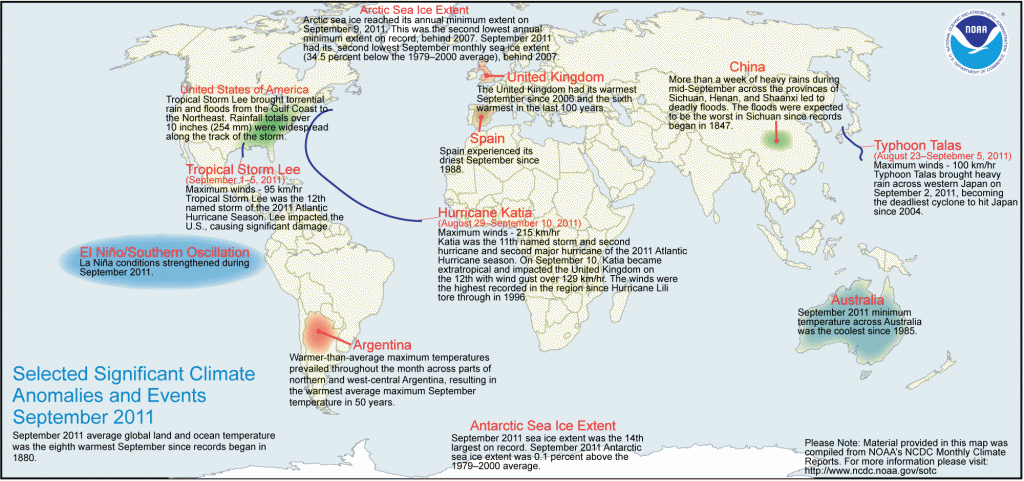17 October 2011
Developing La Nina Cools The Planet in September
Posted by Dan Satterfield
The developing La Nina in the Pacific has brought the global temperature in September down slightly, but it was still the 8th warmest on record. NASA does a separate calculation and ranks Sep. 2011 as 9th warmest. When a La Nina develops the world’s largest ocean sees noticeably cooler surface waters. This chills the air enough to bring the global temperatures down, while El Nino does just the opposite. The super El Nino in 1998 still ranks as one of the hottest years recorded on the planet since reliable temp. records began.
Keep in mind that this is a natural fluctuation on top of the steadily increasing forcing from greenhouse gases, so in spite of the La Nina cooling the planet some, this past September was still ranked as the 8th warmest on record. Some more on the global temps from NCDC here:
The January – September worldwide land surface temperature was 0.80°C (1.44°F) above the 20th century average — the 7th warmest such period on record. The margin of error is +/- 0.20°C (0.36°F). The global ocean surface temperature for the year to date was 0.41°C (0.74°F) above the 20th century average and was the 12th warmest such period on record. The margin of error is +/- 0.04°C (0.07°F).
- The combined global land and ocean average surface temperature for September 2011 was the eighth warmest on record at 15.53°C (59.95°F), which is (0.53°C) 0.95°F above the 20th century average of 15.0°C (59.0°F). The margin of error associated with this temperature is +/- 0.11°C (0.20°F).
- Separately, the global land surface temperature was 0.87°C (1.57°F) above the 20th century average of 12.0°C (53.6°F), making this the fourth warmest September on record. The margin of error is +/- 0.24°C (0.43°F).




 Dan Satterfield has worked as an on air meteorologist for 32 years in Oklahoma, Florida and Alabama. Forecasting weather is Dan's job, but all of Earth Science is his passion. This journal is where Dan writes about things he has too little time for on air. Dan blogs about peer-reviewed Earth science for Junior High level audiences and up.
Dan Satterfield has worked as an on air meteorologist for 32 years in Oklahoma, Florida and Alabama. Forecasting weather is Dan's job, but all of Earth Science is his passion. This journal is where Dan writes about things he has too little time for on air. Dan blogs about peer-reviewed Earth science for Junior High level audiences and up.